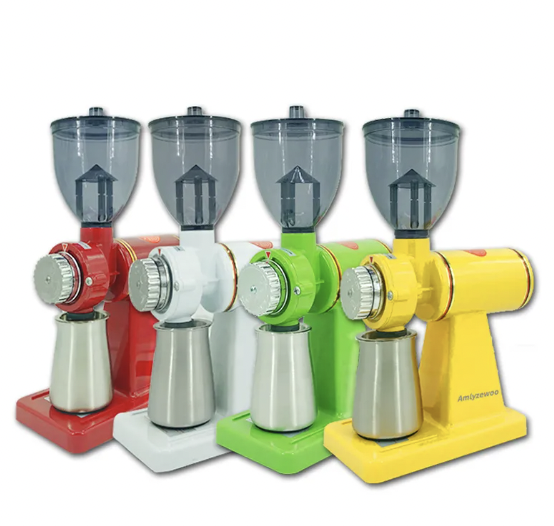There's a saying among coffee enthusiasts: "The grinder is more important than the coffee machine." This might sound surprising, but it's fundamentally true. You can have the world's finest, most freshly roasted coffee beans, but if you grind them poorly, you'll never unlock their full potential. The gateway to exceptional coffee at home isn't a $3,000 espresso machine—it's a quality burr grinder.
This guide will walk you through everything you need to know to choose the perfect burr grinder for your specific needs, budget, and brewing methods. We'll move beyond the marketing hype and focus on the practical, technical, and experiential factors that truly matter.
Why a Burr Grinder? The Foundation of Flavor
Before we dive into the "how," let's solidify the "why." There are two main types of coffee grinders: blade grinders and burr grinders.
Blade Grinders: These use a propeller-like blade to chop the beans randomly and inconsistently. The result is a mix of large boulders, medium particles, and fine dust. When brewed, this uneven grind leads to simultaneous under-extraction (from the large pieces, yielding sour, weak flavors) and over-extraction (from the fine dust, yielding bitter, harsh flavors). It muddies the coffee's true character.
Burr Grinders: These crush beans between two abrasive surfaces (the burrs). The key feature is that the distance between the burrs is precisely adjustable, determining the size of the ground particles. This results in a consistent, uniform grind. Uniformity is the secret to balanced extraction, where all the delicious sugars, acids, and aromatic oils dissolve into your cup at the same rate, revealing the bean's intended flavor profile.
The bottom line: If you are serious about coffee, a burr grinder is not an option; it is the first and most important investment you will make.
Step 1: Understand the Two Main Types of Burrs
The heart of any grinder is its burr set. The type of burr plays a significant role in the grinder's performance, noise, and cost.
1. Conical Burrs
Design: A cone-shaped burr sits inside a ring-shaped outer burr. Beans are fed through the center and crushed as they travel down through the narrowing gap.
-
Pros:
Generally more affordable.
Typically slower, which reduces heat buildup (heat can scorch coffee and damage volatile aromatics).
Often quieter than flat burrs.
Less prone to clogging with oily beans.
-
Cons:
Can produce a slightly less uniform grind compared to high-quality flat burrs, though excellent models exist.
2. Flat Burrs
Design: Two parallel, ring-shaped burrs are placed face-to-face. One rotates while the other remains stationary. Beans are fed from the center and pushed outward by centrifugal force as they are ground.
-
Pros:
Known for producing a very uniform, consistent grind, which can lead to greater flavor clarity and separation.
Often faster than conical burr grinders.
-
Cons:
Generally more expensive.
Can generate more heat and noise due to higher RPMs.
Can be harder to clean and more susceptible to clogging with oily beans.
Which should you choose? For most home users, a good-quality conical burr grinder is an excellent and reliable choice. If you are a discerning enthusiast chasing the ultimate in flavor clarity and uniformity for pour-over or espresso, and your budget allows, a high-end flat burr grinder is a worthy investment.
Step 2: Define Your Brewing Method & Grind Range Needs
This is the most critical step in your decision-making process. Different brewing methods require wildly different grind sizes. Your grinder must be capable of not only achieving these sizes but also adjusting precisely within them.
Espresso (Fine Grind): This is the most demanding application. It requires a very fine, powdery grind and, most importantly, micro-adjustments. The difference between a perfect 25-second shot and a sour or bitter one can be a fraction of a turn on the grind dial. Your grinder must have fine, precise adjustability.
Pour-Over / Drip (Medium Grind): This requires a consistent medium grind, similar to coarse sand. While not as demanding as espresso, the ability to make small adjustments is still crucial for dialing in the perfect brew time and flavor balance.
French Press / Cold Brew (Coarse Grind): This requires a consistent, coarse grind, similar to sea salt. The main challenge for grinders here is avoiding "fines" (small, dusty particles) that can slip through the mesh filter and make the coffee muddy.
The "All-Purpose" Grinder Trap: Be wary of grinders that claim to do "espresso to French press" unless they are specifically designed for it (like the Baratza Encore ESP or Fellow Opus). Many entry-level burr grinders have an adjustment range that is too coarse for proper espresso, or they lack the fine control needed to dial it in.
Step 3: Key Features to Evaluate
Once you know your burr type and required grind range, it's time to compare features.
1. Grind Consistency (The Most Important Metric)
This is the primary job of the grinder. Read professional and user reviews to see how uniform the grind is for your intended brewing method. Look for photos of the grounds if possible.
2. Adjustability
Stepped Adjustments: The grind chamber clicks between predefined settings (e.g., 1-40). This is good for reproducibility but can be limiting for espresso, where you might need a setting between 5 and 6.
Stepless Adjustments: Allows for infinite adjustments between settings. This is the gold standard for espresso, as it gives you ultimate control. However, it can be harder to reproduce settings if you switch between different brew methods frequently.
3. Grind-On-Demand vs. Grind-Hopper
Grind-On-Demand (No Hopper): Beans are stored in an airtight container and only ground when you activate the machine. This is ideal for minimizing stale grounds and retaining the freshness of your whole beans. Common in high-end and commercial grinders.
Grind-Hopper: A clear plastic or metal hopper sits on top, holding your beans. While convenient, beans left in the hopper are exposed to light and air, causing them to stale faster. Better for households that go through coffee very quickly.
4. Static & Retention
Retention: This refers to the amount of ground coffee that gets stuck inside the grinder. Low retention means you get more of the coffee you just ground and less old, stale coffee from the last session mixing in.
Static: Ground coffee can create a lot of static electricity, causing it to cling to the grinder's exit chute and your grounds catcher. Some grinders have anti-static technologies (like the Baratza "grounds bin" design or Fellow's ionizer in the Ode Grinder) that dramatically reduce this messy phenomenon.
5. Noise Level
Burr grinders are not silent. However, slower-spinning conical burr grinders tend to be quieter than high-RPM flat burr models. If you have a sleeping household, this is a factor worth considering.
6. Build Quality & Durability
Look for grinders with metal or high-quality, durable plastic construction. The best brands (like Baratza) are famous for their repairability, offering spare parts and repair guides to extend the life of your grinder for decades.
Step 4: Set Your Budget and Explore Recommendations
Budget: Under $100
Focus: Entry-level conical burr grinders capable of drip and pour-over.
Recommendation: Baratza Encore. It's the undisputed champion in this category. It offers excellent grind quality for the price, is incredibly durable, and is fully repairable. It's the perfect starting point for anyone leaving blade grinders behind.
Mid-Range: $100 - $250
Focus: Improved consistency, more features, and entry into espresso.
-
Recommendations:
Baratza Encore ESP / Fellow Opus: Specifically designed for all-purpose grinding, including espresso. They feature special adjustment systems to provide the micro-control needed for dialing in shots.
DF64 (or similar): A game-changing grinder that brings commercial-grade 64mm flat burrs into the home user's price range. Beloved by espresso enthusiasts for its performance and moddability.
High-End: $250+
Focus: Ultimate grind consistency, speed, durability, and specialized performance.
-
Recommendations:
Baratza Vario / Forte: Excellent flat burr grinders known for their consistency across a wide range.
Eureka Mignon Series: Italian-made workhorses, often considered the best-value dedicated espresso grinders.
Niche Zero: A revolutionary conical burr grinder with near-zero retention, beloved for its simplicity, quiet operation, and ability to switch between brew methods effortlessly.
Conclusion: Your Path to a Perfect Cup
Choosing the best burr grinder is a personal journey that hinges on your brewing habits, flavor expectations, and budget. Don't get lost in the specs alone. Remember the hierarchy of importance:
Grind Consistency: This is non-negotiable.
Appropriate Grind Range: Ensure it can handle your primary brewing method.
Features & Usability: Consider noise, retention, and ease of cleaning.
Budget & Value: Invest as much as you can reasonably afford, as a good grinder will last for years.
By following this guide, you're not just buying an appliance; you're investing in the key that unlocks the true, delicious potential locked within every coffee bean. Your future self, savoring a perfectly balanced and nuanced cup of coffee, will thank you.




